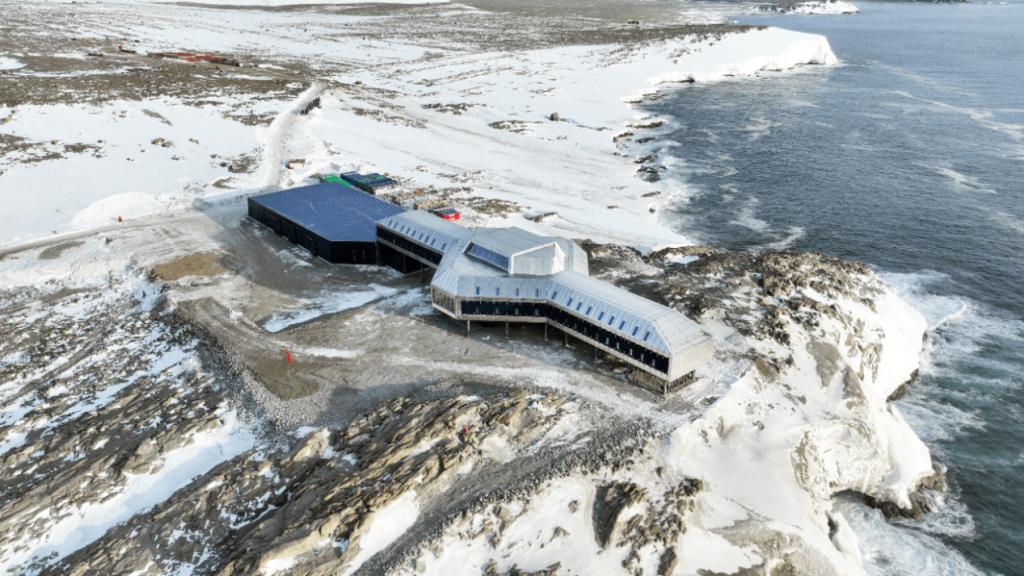China promotes research projects and environmental conservation in Antarctica

On February 7, the construction of Qinling Station was officially completed on Inexpressible Island in the Ross Sea in Antarctica. Chinese President Xi Jinping sent warm congratulations, noting: “The completion of the Chinese Qinling Station in Antarctica will be a reliable guarantee for scientific researchers in China and the whole world to continue searching for the secrets of nature and conquering the heights of science”.
Antarctica is known as the “golden key to unlocking the Earth’s mysteries” and “a natural science laboratory.” The study of Antarctica has enormous scientific value. Due to its unique geographic and natural conditions, changes in the Antarctic environment have an immeasurable impact on the global climate situation.
Qinling Station is the fifth Antarctic research station built by China after Changcheng, Zhongshan, Kunlun and Taishan stations, and the third station that can operate all year round. This year marks the 40th anniversary of the start of the Chinese polar expedition. Over the past 40 years, China has formed an Antarctic expedition model with five stations, two ships and one base, entering the era of three-dimensional development in sea, land and air.
Changcheng station is located on King George Island, Zhongshan station is in the Larsmann Oasis, Kunlun and Taishan stations are in the interior of Antarctica, and Qinling station is in the Ross Sea area. Significant differences in geographic location also facilitate greater scientific research.
The environmental conditions in the Changcheng Station area are suitable for sub-Antarctic environmental monitoring and research; the Zhongshan station area is an ideal place for observing and studying the evolutionary processes of the Antarctic ice sheet and the interaction of the Antarctic shelf with the ocean, as well as an excellent area for conducting scientific work in such disciplines as atmospheric physics, geology, geophysics, etc.; Kunlun and Taishan stations are located in the Antarctic interior, allowing for in-depth research in advanced scientific fields such as ice cores, meteorology and astronomy; The Ross Sea is characterized by multi-circular interactions between the lithosphere, cryosphere, biosphere, atmosphere and other spheres in the Earth system, which contributes to the consideration of such significant scientific problems as changes in the Antarctic and global interconnections and interactions.
Over the past 40 years, China has become a strong supporter of scientific research in Antarctica and has achieved a number of breakthroughs in the fields of Antarctic glaciology, astronautics, bioecology and climate change science.
Changcheng Station during the Antarctic expedition; During the 19th Antarctic Expedition, China tracked and monitored changes in the Antarctic Sea ice thickness for the first time in the world; During the 21st Antarctic Expedition, researchers set out to study the ice cap located in the inner continent of Antarctica, reached Ice Dome A from Earth and conducted significant scientific research for the first time in the history of human scientific exploration in Antarctica.
In recent years, China has made continuous observations of the atmosphere, ocean, sea ice, glaciers, soil, biological ecology and other elements of Antarctica, making important contributions to the international community’s study of the polar regions, in particular the interaction between global climate change and Antarctica.
Over the past 40 years, China has been actively protecting the Antarctic environment. In early September 1990, Changcheng Station temporarily suspended all modes of transportation to allow the seal mother living in the station area to spend her maternity leave in a favorable environment. All team members participating in expedition activities walked.
In 2008, the 31st Antarctic Treaty Consultative Meeting (ATCM) approved a proposal calling for China to establish Antarctica’s first specially protected area in the Grove Hill-Harding Hill area. This has had a positive impact on environmental protection in the region.
The first icebreaker independently built by China, Xuelong-2, is deservedly called a “Green” ship. Its exhaust pipe, wastewater and garbage control system, real-time air conditioning and heating control, and even its paint are strictly environmentally friendly.
Throughout the construction of Qinling Station, the builders adhered to environmental protection requirements. Through comprehensive design coordination, the station was custom-built, resulting in savings in energy, water and materials. In addition, by reducing the construction area at the Antarctic site, reducing the number of temporary structures and personnel on the construction site, and maximizing the control of the scale of construction work, the goal of constructing the station in an environmentally friendly and environmentally friendly manner was achieved.
Over the past 40 years, China has become an important player in the international governance of Antarctica. China acceded to the Antarctic Treaty in 1983 and became a Consultative Party to the ATCM in October 1985, gaining decision-making power in international polar affairs.
In 2017, China successfully organized the 40th ATCM and the 20th meeting of the Antarctic Environment Committee, and also led the launch of the international Green Expedition initiative, which was widely recognized by the international community; In 2023, China and several other countries jointly submitted a proposal to promote international cooperation on aerial photography of the Antarctic ice cap and improve the accuracy of forecasting global sea level rise, gaining the support of the meeting members. Since 2012, China has submitted more than 80 proposals to international organizations governing polar affairs. The PRC has participated in the development of rules and regulations for a system for protecting the polar environment and conserving resources on a comprehensive scale.
Source: People’s Daily online
